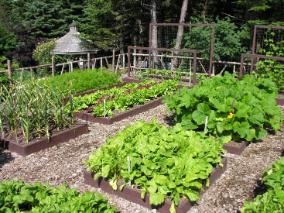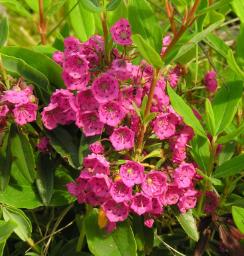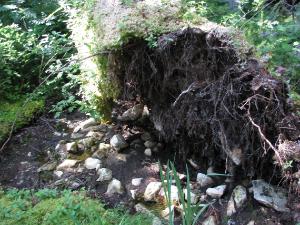Gardening Information

It can be a challenge creating your ideal garden in a province where it tends to be the exception and not the rule. Botanical Garden staff have taken the time to prepare resources that address the challenges specific to Newfoundland and Labrador, as well as some general information for gardeners near and far.
- Gardening Articles on Specific Plant Groups
- Gardening for the Seasons
- Gardening for Wildlife
- Vegetables & Fruits
- Rock Gardening
- Gardening with Natives
- Sensory Gardening
- Newfoundland Soil
- Giant Hogweed Identification
Gardening Articles on Specific Plant Groups
The following links provide gardening information relevant to our local area (St. John's, NL):
- Gardening With Annuals
- Growing Annuals From Seed
- Gardening with Primulas
- Primula Selection
- Growing Heaths and Heathers
- Gardening With Hostas
- Growing Rhododendrons
- Hydrangeas in Newfoundland
- Gardening With Brunnera
- Gardening With Canadian Bred Roses
- Dwarf Ferns in the Garden
- Gardening With Scilla & Relatives
- Gardening With Turtleheads
- Gardening With Ornamental Avens
- Gardening With Erythronium
- Gardening With Chamaecyparis
- Gardening With Monkshood
- Flowering in Fall - Anemone
- Maidens Blush Rose
- Bouncing Bet
- Common Peony
- Delphinium
- Queen of Meadow
Gardening for the Seasons
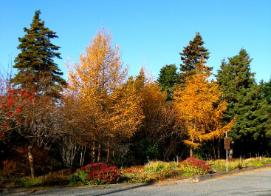
Gardening for Wildlife

From bees to birds to butterflies, wildlife can be exciting and beneficial visitors to have in your garden. The Botanical Garden's wildlife-friendly garden has been an exciting opportunity to investigate which plants are most attractive to the various critters.
The following article has a list of plants which Garden staff has found most effective:
As much as you may love wildlife in your garden they may also cause trouble. See our moose resistant plants list.
- Breaking Ground
- A Guide to The Bees of Insular Newfoundland
- Gardening for Pollinators: Powerpoint & Handout
- Newfoundland and Labrador Beekeeping Association
- Top 10 Ornamental Bee Flowers
Vegetables & Fruits
Despite the short growing season, there is a variety of vegetables and fruits that can be successfully grown on the Avalon Peninsula. The Botanical Garden has a small demonstration vegetable garden which features a wide variety of produce as early as mid-June, as well as some fruiting trees and shrubs.
To learn more, please visit our WORKSHOP page for a list of upcoming programs.
Some of the vegetables that have successfully been grown in the past include (varieties often change every year):
- potatoes
- spanish onions
- beans (both climbers and bush beans)
- peas
- cabbage
- squash
- leek
- garlic
- lettuce
- carrots
- radish
- tomato (both outside and in the greenhouse)
- cucumber (in the greenhouse)
Other Resources:
- When to Plant
- Choice Vegetables for a Newfoundland Garden
- Floating Row Covers for Vegetable Beds
- Vegetable Gardening in Raised Beds: Powerpoint & Sheet
- Growing Fruit in Newfoundland
- Recommended Fruit Cultivars for Newfoundland
- Growing small-fruit in Newfoundland
- Edible Newfoundland Plants
Rock Gardening
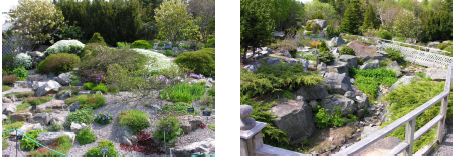
Rock gardens constitute a significant portion of the Garden's cultivated area. Nestled between the Rhododendron border and the Alpine House is the largest of the rock gardens; one area is styled as a traditional rock garden, resembling a mountainside, and the other is a more unique limestone scree, which showcases many native plants. The other rock garden, laying at the gateway to the compost and wildlife-friendly garden, is the crevice garden, which takes a stunning slanted view on showcasing alpine plants.
For more information about rock gardening in Newfoundland guide.
Gardening with Natives
Plants and shrubs native to Newfoundland and Labrador offer a stunning display of the virility and heartiness of the plant kingdom. The colours, textures, and shapes exhibited by the foliage, buds, and blooms are a fabulous addition to any garden. Natives are incorporated throughout the cultivated gardens, with a high percentage of the medicinal, peat, and woodland beds being native plants. The nature trails also offer a look at native plants in their natural environments. August is a great month to spot several of the native orchids and mid-summer is often the time to see the Garden’s emblem, the twinflower, in bloom along the Yetman Trail.
Native ornamental plants for the Garden
List compiled by Todd Boland, Research Horticulturist, MUN Botanical Garden
Native Trees
White Spruce – Picea glauca
Black Spruce – Picea mariana
Balsam Fir – Abies balsamea
Red Pine – Pinus resinosa
White Pine – Pinus strobus
Red Maple – Acer rubrum
White Birch – Betula papyrifera
Yellow Birch – Betula alleghaniensis
Chokecherry – Prunus virginiana
Dogberry – Sorbus americana/decora
Native Shrubs
Bearberry – Arctostaphyllos uva-ursi
Bayberry – Myrica pensylvanica
Bunchberry – Cornus canadensis
Red-osier Dogwood – Cornus stolonifera
Pagoda Dogwood – Cornus alternifolia
Common Juniper – Juniperus communis
Creeping Juniper – Juniperus horizontalis
Purple Chokeberry – Aronia floribunda
Virginia wild rose – Rosa virginiana
Bush honeysuckle – Diervilla lonicera
Rhodora – Rhododendron canadense
Highbush Cranberry – Viburnum trilobum
Northern wild raisin – Viburnum cassinoides
Winterberry holly – Ilex verticillata
Chuckley-pear – Amelanchier
Red Elderberry – Sambucus pubens
Dwarf Birch – Betula pumila
Fabulous Ferns - It’s About the Foliage
Maidenhair fern - Adiantum aleuticum
Lady fern – Athyrium filix-femina
Wood fern – Dryopteris species
Ostrich fern – Matteucica struthiopteris
Cinnamon ferns – Osmunda cinnamomea
Royal fern – Osmunda regalis
Beech fern – Phegopteris connectilis
Holly fern – Polystichum braunii
New York fern – Thelypteris noveboracens
Herbaceous Perennials
Joe-pye weed – Eutrochium maculatum
Canada burnet – Sanguisorba canadensis
Blue Flag – Iris versicolor
Marsh Marigold – Caltha palustris
Goldenrods – Solidago species
Asters – Symphyotrichum species
Meadowrue – Thalictrum pubescens
Woodlanders for Dappled Shade
Bluebead lily – Clintonia borealis
Wild lily-of-the-valley – Maianthemum canadense
Twisted stalk – Streptopus species
Baneberry - Actaea rubra
Star-flowered False Solomon’s-seal – Maianthemum
stellatum
Rock Stars - Native Alpines
Pussytoes – Antennaria species
Hyssop-leaved fleabane – Erigeron hyssopifolius
Violets – Viola species
Balsam ragwort – Packera pauperculus
Dwarf goldenrod – Solidago hispida/multiradiata
Harebell – Campanula rotundifolia
Beach-head iris – Iris hookeri
Roseroot – Rhodiola rosea
Blue-eyed grass – Sisyrinchium angustifolium
Crant’z cinquefoil – Potentilla crantzii
Encrusted saxifrage – Saxifraga paniculata
For more information about gardening with native plants, the Garden Gift Shop has several resources for sale.
Newfoundland Soil
Newfoundland's "soil" is very rocky (hence the province's nick-name), and often promotes a very shallow root system, making our plants even more susceptible to wind blow-down. To maintain the ideal garden amending your soil is key. But with what?
You can start with having your soil analyzed in one of the province's laboratories for a minimal charge:
What is soil?
Soil is a natural medium for the growth of plants and furnishes the plant with an anchor of its roots as well as nutrients (including water) and oxygen for growth and reproduction.
Soils consist of four components:
-mineral material
-organic matter
-water
-air
Micro and macro-organisms : micro (bacteria, fungi, algae)
macro (earthworms, beetles, nematodes)
In the soil mixes used at the Botanical Garden all these components are present in different percentages depending on it intended use.
Rock Garden mix: 1 part screened topsoil (mineral), 1 part leaf mold (organic), 1 part grit (mineral for drainage)
Peat Garden mix: 4 parts peat, 2 parts leaf mold, 1 part grit
Perennial Garden mix: 5 parts screened topsoil, 2 parts leaf mold, 1 part grit
Soil texture is one way to describe a soil. It is sometimes called the “feel” of the soil and gives a measure of the proportions and abundance of different sizes of mineral and rock particles (sand, silt, clay). This controls the physical behaviour of the soil such as drainage, moisture content, plant nutrient supply and workability. The texture classes run from heavy clay to sandy loam and combinations of each.
Soil structure is a measure of how well the soil particles are aggregated into crumbs with pore networks of different sizes connecting them and thus refers to the physical arrangement of the mineral and organic particles in the soil. The soil structure affects movement of air and water through the soil and influences the supply of water, air and nutrients to the plant roots.
Soil reaction refers to the pH of the soil. It is a measure of the degree of acidity or alkalinity. It is measured on a scale of 0 to 14, with less than 7 being acid, 7 neural and more then 7 alkaline. A simple pH test can be done with litmus paper where the degree and quickness of the colour change can give a rough idea of your soil’s pH. Soil reaction is important to plant nutrition because (1) it has an effect on solubility and availability of soil minerals. (2) It affects the soil microorganisms and therefore the breakdown of organic matter and nutrient availability. (3) At extremes of high and low pH a plants’ roots can become stunted which in turn affects nutrient uptake. Newfoundlands soil is fairly acidic (low pH) and this is why we add lime to many of our gardens to raise the pH to neutral or slightly alkaline. Most garden plants (excluding members of the Ericaceae family such as Rhododendrons and Heathers) prefer a soil pH of 6.5-7.5.
Q: What do the numbers on a bag of fertilizer mean?
A: These numbers refer to the macronutrient content of the fertilizer. The first number is nitrogen (N), the second is phosphorous (P) and the third represents the potassium (K) content. A bag of 5-10-5 is 5% N, 10% P and 5% K. N encourages vegetative growth, gives a dark green colour, is necessary for chlorophyll formation and is required by soil microorganisms so that decomposition of organic matter can occur. P stimulates early root development and is necessary for flower, fruit, and seed formation. K strengthens stems and leaves, promotes vigor and disease resistance. Some formulations contain micronutrients such as boron, copper, iron, manganese, molybdenum, and zinc. These will be listed on the bag.
Q: What formulation should I use?
A: That depends what you want it to do. For established lawns, in spring, it should be high in N to encourage healthy, green vegetative growth, not flowers and roots, such as 24-4-8. Many are slow release and will give continuous feed for the duration of our growing season. Read the bag. In the fall, you can use a fall lawn fertilizer which is high in phosphorus (6-18-16) to encourage good root growth and therefore better winter hardiness. For vegetables 5-10-10 would be good to promote strong root growth and increase disease resistance. For a perennial flower bed, 5-10-5 works well and is lower in nitrogen to avoid lush growth and higher in phosphorus to encourage flowering. Follow directions, too much is worse than none at all.
Q: Why do you add organic matter to the flower beds?
A: We add organic matter in the form of a mulch of leafmold (shredded, composted leaves) and peat moss (2:1). It is applied in May after the soil has warmed up and has two major benefits. It helps keep moisture in, weeds out, cools roots on hot days, and the dark colour really shows off the flowers and foliage. A nice layer of mulch (1-2”) can protect newly planted perennials and help less hardy plants through the winter. The next spring this layer of leafmold and peat is dug into the soil around the plants. This is the second and most important benefit. The organic matter improves the structure of the soil, allowing free passage of water and air. It darkens soil from brown to black which helps to warm the soil in the spring, accelerating root growth and germination. It reduces baking and crusting of the soil surface that could interfere with emergence of seedlings and absorption of water. Organic matter adds body to dry, sandy soils and helps to check erosion, increase water holding capacity, supply plant nutrients (especially leafmold) and act as a “storehouse” for nutrients. It is also a food source for earthworms and microorganisms important for plant growth.
Learn more about composting - a fantastic additive to your soil.
Giant Hogweed Identification
We receive many calls from concerned members of the public who believe they may have found a stand of the invasive giant hogweed. This species is exceedingly rare in our province, and the plant in question is most commonly cow parsnip. The information sheet linked below provides images and text descriptions that lay out the differences between these two species.
